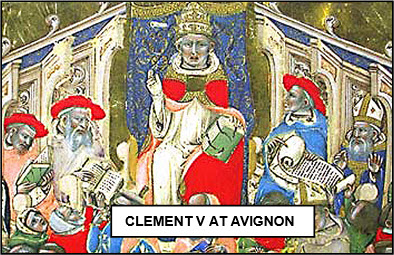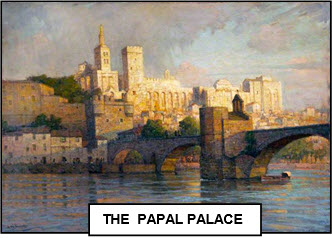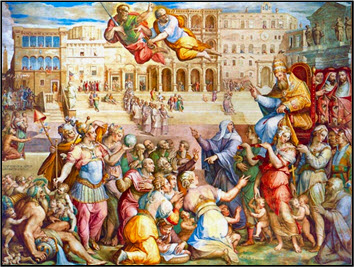


THE END OF THE BABYLONIAN CAPTIVITY 1377 (E3)
Including:
Pope Gregory XI

xxxxxAs we have seen, it was in 1309 (E2) that a newly elected pope, to gain a measure of peace and security, took up residence at Avignon in southern France, thus starting the Babylonian Captivity. Here, the papacy came under French influence. All seven popes at Avignon were Frenchmen! As a result there was much opposition to this move, especially in England and Germany. Some good was achieved during this period -
xxxxxWe have seen how, at the beginning of the last reign (Edward II), the prestige and power of the papacy had fallen to an all-
 xxxxxAt Avignon, of course, the papacy came under strong French influence, and it is hardly surprising that all seven Avignonese popes were in fact Frenchmen. (And of the 134 cardinals appointed during this period 111 were French!). However, the papal stay at Avignon was not without benefit. During this period, a marked reorganisation of church administration and some reform of clerical conditions were achieved, and missionary work was also expanded. However, there was much opposition to this “captivity”, especially in England and Germany, and this did much damage to the prestige of the papacy.
xxxxxAt Avignon, of course, the papacy came under strong French influence, and it is hardly surprising that all seven Avignonese popes were in fact Frenchmen. (And of the 134 cardinals appointed during this period 111 were French!). However, the papal stay at Avignon was not without benefit. During this period, a marked reorganisation of church administration and some reform of clerical conditions were achieved, and missionary work was also expanded. However, there was much opposition to this “captivity”, especially in England and Germany, and this did much damage to the prestige of the papacy.
 xxxxxThus by the 1360s there were many churchmen who argued for a return of the papacy to Rome. In its absence, the church lands in Italy had come under serious threat from an aggressive Florence, and its loss of ecclesiastical authority had undermined the status of the Roman Catholic Church throughout Europe. Many feared that such a situation would continue and might become worse while the papal court remained at Avignon. Indeed, in 1367 the then pope, Urban V, had returned to Rome for some three years in a vain attempt to re-
xxxxxThus by the 1360s there were many churchmen who argued for a return of the papacy to Rome. In its absence, the church lands in Italy had come under serious threat from an aggressive Florence, and its loss of ecclesiastical authority had undermined the status of the Roman Catholic Church throughout Europe. Many feared that such a situation would continue and might become worse while the papal court remained at Avignon. Indeed, in 1367 the then pope, Urban V, had returned to Rome for some three years in a vain attempt to re-
 xxxxxGregory XI, who became pope in 1370, was strongly in favour of a return to Rome, but the move had to be delayed for a number of years. Before his departure he had two aims in mind: to bring an end to the war between England and France, resumed in 1369, and to defeat the city of Florence, busily involved in a war against the Papal States. He failed in his first aim, but succeeded in his second. Having concluded peace with Florence at the end of 1376, he decided to move back to Rome. This he did in January 1377 (illustrated), despite opposition from a number of cardinals, and, as one would expect, the French monarchy.
xxxxxGregory XI, who became pope in 1370, was strongly in favour of a return to Rome, but the move had to be delayed for a number of years. Before his departure he had two aims in mind: to bring an end to the war between England and France, resumed in 1369, and to defeat the city of Florence, busily involved in a war against the Papal States. He failed in his first aim, but succeeded in his second. Having concluded peace with Florence at the end of 1376, he decided to move back to Rome. This he did in January 1377 (illustrated), despite opposition from a number of cardinals, and, as one would expect, the French monarchy.
xxxxxThe return to Rome was an important one; from henceforth the papal headquarters were to remain in this city. However, as we shall see, the move brought more troubles than it set out to solve. On the death of Gregory, the Italian Urban VI was elected in his place, but he proved unacceptable to the cardinals of Avignon, who had grown to be a significant power-
Acknowledgements
Avignon: manuscript artist unknown – Departmental Archives of Vaucluse, Avignon. Papal Palace: by English painter Albert Moulton Foweraker (1873-
E3-


